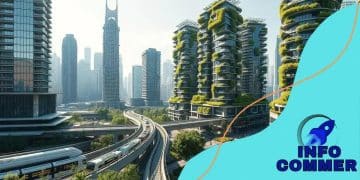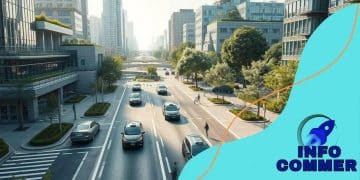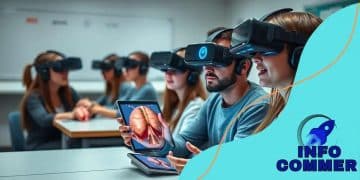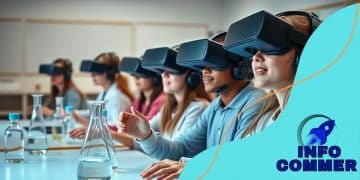Augmented reality for urban planning: the future is here
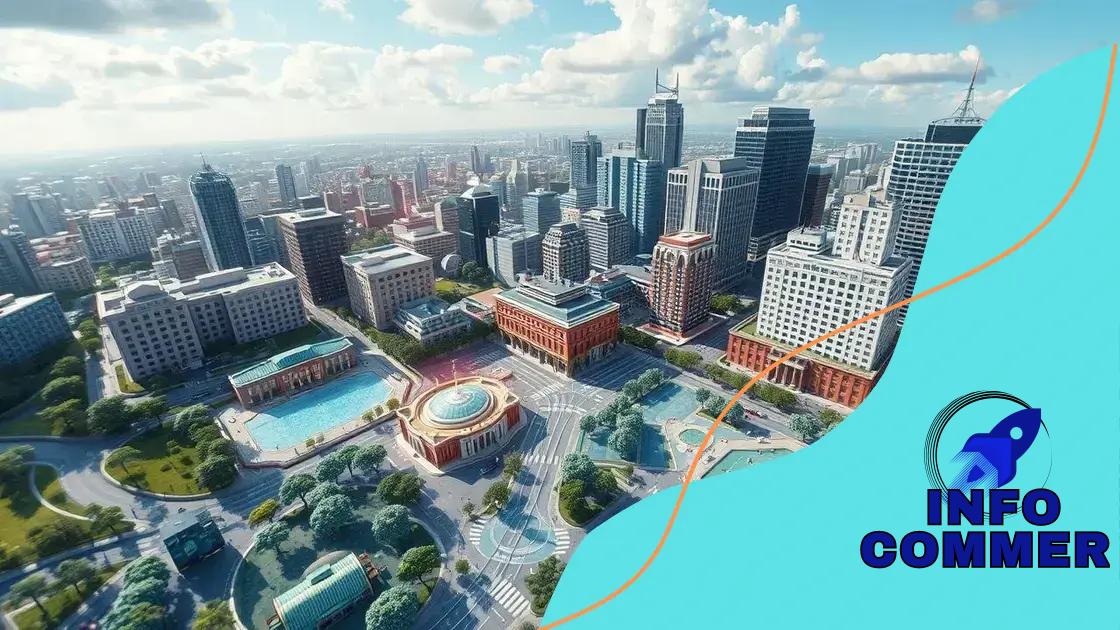
Augmented reality enhances urban planning by visualizing developments in real-time, improving community engagement, and streamlining decision-making processes, paving the way for smarter, more connected cities.
Augmented reality for urban planning and development is reshaping how we visualize and engage with our cities. Imagine walking through your neighborhood and seeing digital overlays that reveal future developments. Intrigued? Let’s dive into how this technology is changing the urban landscape.
Understanding augmented reality in urban planning
Understanding augmented reality in urban planning is crucial for enhancing the way we develop and visualize our cities. This technology allows planners to blend the physical environment with digital elements, creating immersive experiences. With augmented reality, stakeholders can see proposed developments within their existing surroundings.
What is augmented reality?
Augmented reality (AR) is a technology that overlays digital information onto the physical world. In urban planning, AR provides tools to visualize architectural designs and city layouts on-site, making the planning process more efficient and engaging.
Benefits of using augmented reality in planning
- Improved visualization: Stakeholders can better understand how new developments will integrate into the existing environment.
- Enhanced public engagement: AR encourages community members to participate in the planning process by visualizing changes in real-time.
- Faster decision making: With clear visual representations, decision makers can quickly evaluate proposals and their impacts.
As people walk through future developments enhanced by augmented reality, they can visualize where buildings will be placed and how they will affect the community. This technology not only streamlines communication but also fosters collaboration among planners, policymakers, and residents.
Examples of augmented reality in urban planning
Many cities are already deploying AR to enhance urban development projects. For instance, some municipalities offer mobile applications that allow users to view 3D models of proposed structures overlaying the actual environment. This innovation provides whether these projects align with community values and aesthetics.
Furthermore, by using augmented reality, urban planners can simulate day-to-day functions within the new spaces, from pedestrian traffic to environmental sustainability. The possibility of viewing the future while standing in the present opens a new realm of understanding.
How augmented reality enhances public participation
Augmented reality significantly enhances public participation in urban planning by actively engaging community members in the decision-making process. When citizens can visualize proposed changes in their environment, they often feel more connected and invested in the outcomes.
Interactive community engagement
Through augmented reality, planners can create interactive experiences where the public can leave feedback on new designs in real time. This immediacy allows for richer discussions and ideas to shape the plans effectively.
- Visualization tools: AR apps allow users to see how new developments fit into their surroundings.
- Real-time feedback: Community members can suggest changes as they view proposals.
- Increased attendance: Engaging formats attract more participants to meetings.
AR’s immersive aspect makes it easier for residents to understand complex plans. For example, when a local park is redesigned, an AR app can overlay the new layout onto the actual site. Residents can walk through and give their opinions while exploring the space.
Fostering collaboration
By using augmented reality, cities can break down barriers between officials and residents. This collaboration leads to more inclusive and representative urban planning. When everyone can access and visualize the same information, it creates a common ground for discussions.
Moreover, this technology empowers underrepresented groups to voice their opinions. By making planning processes accessible and engaging, cities can ensure that the needs of diverse populations are met. AR becomes a bridge that connects community aspirations with urban development.
Success stories of augmented reality in city projects
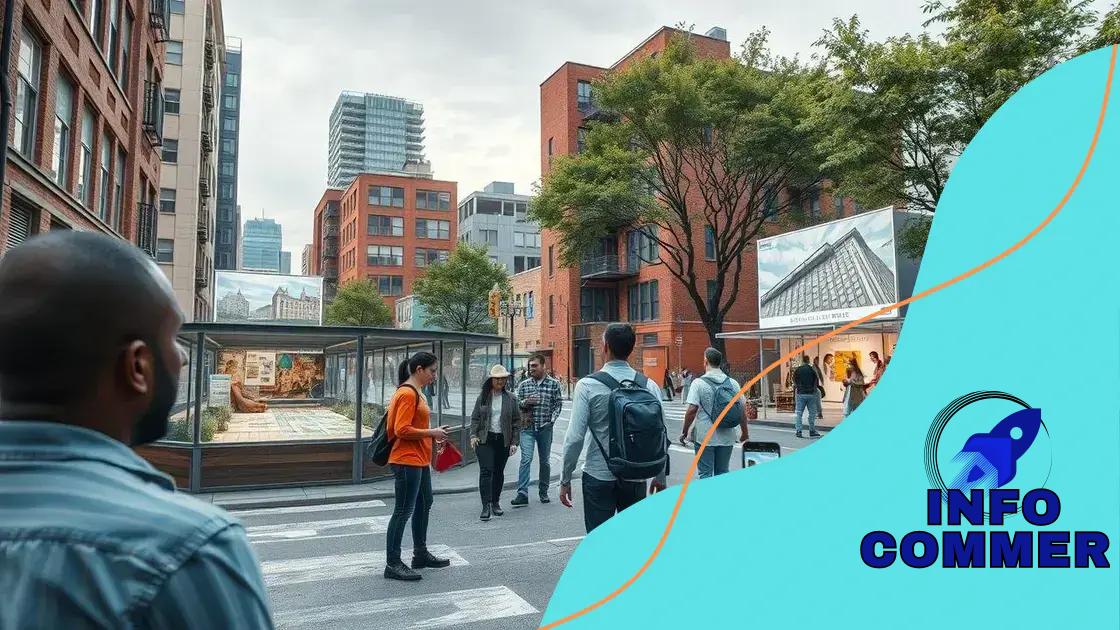
Success stories of augmented reality in city projects demonstrate how this technology can transform urban planning. Cities worldwide are adopting AR to improve project outcomes, engage communities, and streamline processes.
Case Study: Amsterdam’s AR Urban Planning
Amsterdam has implemented AR to help visualize its urban planning initiatives. Residents can interact with virtual models of new buildings and infrastructure directly in their neighborhoods. This interactive approach has led to higher community involvement and positive feedback on proposed changes.
Enhancing Public Spaces in San Francisco
In San Francisco, AR was used to redesign public spaces. By overlaying virtual designs on existing park layouts, planners showcased potential improvements to community members. This method encouraged residents to express their thoughts and desires for the future of the parks.
- Engagement: Residents feel more connected to the planning process.
- Visualization: People can see how proposed changes affect their environment.
- Feedback: Communities can easily provide input on designs they prefer.
Another successful implementation occurred in Helsinki, where AR is used for historical site preservation. Visitors can use an app to overlay images of how sites appeared in the past. This not only educates the public but also promotes tourism and appreciation for local heritage.
Urban Development in Tokyo
Tokyo has pioneered using augmented reality for large-scale urban development projects, allowing planners to visualize concepts before implementation. This technology saves time and resources by identifying potential issues early in the planning process.
These success stories reveal the transformative power of AR in urban environments. By bringing communities together and enhancing transparency, augmented reality is not only changing how cities are planned and developed but also fostering a sense of ownership among citizens.
Challenges of integrating augmented reality in planning
Integrating augmented reality in planning comes with several challenges that urban developers must address to ensure successful implementation. Organizations need to consider technology, training, and community acceptance to make AR a valuable tool.
Technological Limitations
One challenge is the availability of advanced technologies. Many urban planning departments may lack access to the latest AR tools and software. This gap can hinder the effective use of augmented reality in projects.
Training and Skills Gap
Another hurdle is the need for specialized training. Urban planners and city officials must understand how to use AR technology effectively. Without proper training, these tools may not be utilized to their full potential. Regular workshops and training sessions can help bridge this gap.
- Skill Development: Investing in staff training builds confidence and expertise.
- Collaboration: Partnering with tech companies can enhance knowledge sharing.
- Hands-on Practice: Providing opportunities for practical experience with AR tools increases proficiency.
Additionally, community acceptance is critical. Some residents may be skeptical of new technologies or hesitant to change. Engaging the public early in the planning process helps address concerns and build support for AR initiatives. Transparent communication about how AR will benefit the community is essential.
Budget Constraints
Budget constraints can also pose a significant challenge. Implementing augmented reality solutions often requires considerable investment in hardware, software, and training. Cities must carefully evaluate their budgets and seek grants or partnerships to offset costs. Finding the right balance between cost and innovation is crucial for success.
Despite these challenges, many cities are finding ways to overcome them. By fostering collaboration between tech companies, city planners, and residents, the potential of augmented reality in urban planning can be realized. Addressing these issues head-on will lead to a more effective and integrated use of AR.
The future of augmented reality in urban environments
The future of augmented reality in urban environments looks promising, with advancements continuously transforming how cities are designed and experienced. As technology evolves, AR will play an even larger role in urban planning, offering innovative solutions to common urban challenges.
Smart Cities and AR Integration
Smart cities are set to harness the power of augmented reality to enhance daily life for residents. By integrating AR into infrastructure, city planners can provide real-time information to citizens about public transit, traffic conditions, and environmental factors. This access to information helps individuals make informed decisions.
Urban Navigation and Enhancement
Augmented reality can significantly improve urban navigation. City dwellers and tourists can use AR apps to overlay navigation directions onto their surroundings. This feature enhances their experience in new neighborhoods, making exploration more accessible and engaging.
- Real-time updates: AR can provide instant updates on traffic and transit options.
- Visual landmarks: Users can see virtual guides pointing out local attractions and services.
- Interactive experiences: AR can bring historical sites to life, offering immersive learning opportunities.
Furthermore, businesses can benefit from augmented reality by creating interactive storefronts. Customers could use AR to see how products fit into their lives before purchasing, enhancing the retail experience and driving sales.
Community Engagement and Planning
As urban environments evolve, AR will facilitate community participation in planning processes. Residents will have the chance to visualize proposed projects, allowing them to provide feedback and engage with planners more effectively. This transparency can foster a sense of ownership and collaboration within communities.
With the rapid advancement of technology, the potential uses of augmented reality in urban settings are only beginning to be explored. As cities adapt to these innovations, we can expect a more connected, informed, and engaged urban populace, ultimately leading to smarter, more sustainable communities.
FAQ – Frequently Asked Questions about Augmented Reality in Urban Planning
What is augmented reality?
Augmented reality (AR) is a technology that overlays digital information onto the real world, enhancing the way we visualize and interact with our environment.
How can augmented reality improve community engagement in urban planning?
AR allows residents to see proposed developments in their neighborhood, enabling them to provide real-time feedback and participate actively in the planning process.
What are some challenges of integrating augmented reality in planning?
Challenges include technological limitations, the need for training, budget constraints, and ensuring community acceptance of new tools.
What does the future hold for augmented reality in urban environments?
The future of AR in cities includes smarter urban planning, improved navigation tools, enhanced public services, and greater community involvement in decision-making.
